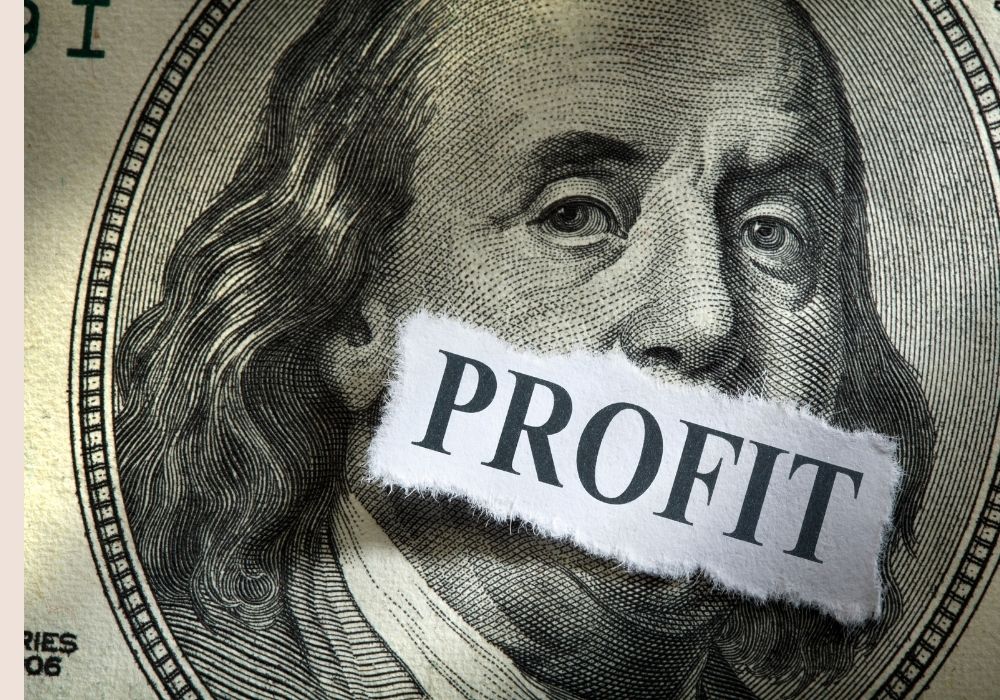In a nutshell, Profit is the amount of cash you take home. But there are more layers to it that we’ll discuss in this article.
Calculating profit can be easy for small businesses, but it can be a little tricky for big companies. The joy part is that profit is the golden number that indicates that your hard work is paying off, or your plan has been successful.
So, without any further ado, let’s break it down, in detail, with a dash of humor, formulas, and examples. We’ll be learning terms like “gross profit” and “net profit” like a pro at a Car washing service.
What Is Profit?
Profit is what’s left after you deduct all the costs of running a business from the money it brings in.
Think of it as the cash you get to keep after paying for everything, like the reward for all that hard work.
Businesses live and breathe on profit, and understanding it is key to figuring out if a business is thriving or just barely getting by.
There are two main types of profit to know: gross profit and net profit. Gross profit is like the rough draft—it’s the money left after paying for the direct costs of making a product or service.
Net profit is the final version, the real deal, after all expenses are subtracted. Let’s unpack these with formulas and examples, and toss in a story or two for good measure.
Gross Profit: The First Step
Gross profit is the starting point. It’s the revenue (the total money earned from sales) minus the cost of goods sold (COGS). COGS includes the direct costs of producing whatever you’re selling, like materials and labor.
For example, if you’re running a Self-care Car Wash service, COGS would cover the rent, tools, staff fees, and maybe some extra wages.
Here’s the formula:
Gross Profit = Revenue – Cost of Goods Sold (COGS)
Example: Car Washing Service
Imagine a sunny Saturday, and you’re a self-serve car washing service at $8 per car. You sell 100 car washes, so your revenue is $800. Now, the COGS includes:
- Electricity: $30
- Water: $20
- Rent: $100
- Random “wages” (any tool): $5
Total COGS = $30 + $20 + $100 + $5 = $155
Plug it into the formula:
Gross Profit = $800 – $155 = $645
Boom! You’ve got $645 in gross profit. That’s the money left before accounting for other expenses like the table rental or the sign you made to advertise. Pretty sweet, right?
A Quick Story: The Cookie Fiasco
Back in the day, a certain teacher (who shall remain nameless but might be explaining this right now) tried selling homemade cookies at a school fair.
The revenue was a solid $100 from selling 50 cookies at $2 each. But the COGS? Flour, sugar, chocolate chips, and butter added up to $40.
So, gross profit was $100 – $40 = $60. Felt like a win—until the other expenses came knocking. More on that later.
Net Profit: The Real Deal
Gross profit is cool, but net profit is where the rubber meets the road. Net profit takes gross profit and subtracts all other expenses—things like rent, utilities, marketing, and taxes.
This is the number that shows whether the business is actually making money or just burning through cash.
Here’s the formula:
Net Profit = Gross Profit – Operating Expenses – Other Expenses (like taxes or interest)
Operating expenses are the costs of keeping the business running, like rent, utilities, or salaries for employees (or that ice cream for your brother if he’s now demanding a raise). Other expenses might include taxes or interest on a loan.
Back to the Car Washing Service
Let’s say your Car wash service has some extra costs:
- Standard Labour fee: $20
- Professional labour fee: $30
- Interior Cleaners: $20
Total operating expenses = $20 + $20 + $30= $70
Now, calculate net profit using the gross profit from earlier ($645):
Net Profit = $645 – $70 = $575
You’re left with $575 to pocket or reinvest in more tools. Not bad for a day’s work!
Another Example: The T-Shirt Business
Imagine you’re selling custom T-shirts online. You sell 200 shirts at $20 each, so revenue is $4,000. The COGS (cost of shirts, ink, and labor) is $2,000. Here’s the gross profit:
Gross Profit = $4,000 – $2,000 = $2,000
Now, operating expenses include:
- Website hosting: $50
- Advertising: $300
- Shipping costs: $150
- Taxes: $200
Total operating expenses = $50 + $300 + $150 + $200 = $700
Net profit:
Net Profit = $2,000 – $700 = $1,300
That’s $1,300 to keep the business growing or maybe treat yourself to some new sneakers. But if those expenses creep up, that number can shrink fast.
The Cookie Fiasco, Part Two
Back to that cookie sale. The $60 gross profit felt great, but then came the operating expenses: $10 for a table, $5 for a fancy sign, and $15 for a school donation “fee.”
Total expenses: $30. Net profit? $60 – $30 = $30. Not exactly a fortune, and definitely a lesson in keeping expenses in check. The cookies were a hit, though—worth every crumb!
Profit Margin: The Percentage Game
Now, let’s talk profit margins. These are percentages that show how much of your revenue turns into profit. They’re like a report card for efficiency. There are two key margins: gross profit margin and net profit margin.
Gross Profit Margin
This shows how much of your revenue is left after COGS, as a percentage:
Gross Profit Margin = (Gross Profit / Revenue) × 100
Using the Car Wash Service:
Gross Profit Margin = ($645 / $800) × 100 = 80.625%
An 80.625% gross profit margin means 80 cents of every dollar earned stays after paying for wages required to run a business. That’s a solid score!
Net Profit Margin
This tells you how much of your revenue is actual profit after all expenses:
Net Profit Margin = (Net Profit / Revenue) × 100
For the Car Wash service:
Net Profit Margin = ($575 / $800) × 100 = 71.875%
So, 71.875 cents of every dollar is pure profit. Not too shabby for a College dropout running a Car Wash empire!
Why Margins Matter
Margins help compare businesses. A high gross profit margin means you’re good at keeping production costs low. A high net profit margin means you’re running a tight ship overall. If your margins are low, it’s time to cut costs or raise prices.
That cookie sale? The net profit margin was ($30 / $100) × 100 = 30%. Decent, but those extra fees hurt. Lesson learned: always check the fine print at school fairs!
A Few Tips to Boost Profit
- Cut COGS Smartly: Find cheaper suppliers or negotiate better deals. Maybe buy tools in bulk next time.
- Watch Operating Expenses: Do you really need that neon sign? A handwritten one might do.
- Increase Revenue: Raise prices (carefully) or sell more. Maybe offer a “premium service combo” with one free wash.
- Track Everything: Use a spreadsheet to monitor costs and sales. It’s like keeping score in a video game—knowing the numbers helps you win.
Wrapping It Up
That’s the end of it. We hope you’ve learned to calculate Profit like a pro. It’s all about knowing your revenue, COGS, and expenses.
Gross profit (Revenue – COGS) gives you the big picture, while net profit (Gross Profit – Operating Expenses – Other Expenses) shows what you keep.
Profit margins turn those numbers into percentages, helping you see how efficient the business is.
Whether it’s a Car Wash service, a T-shirt shop, or a cookie sale gone slightly wrong, these formulas are your toolkit.

